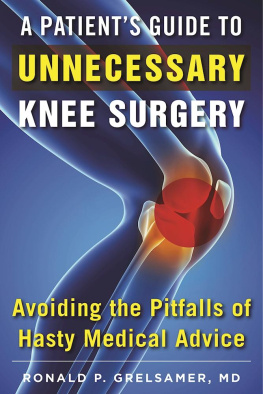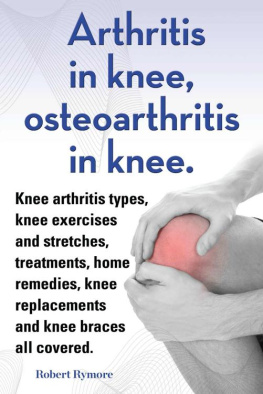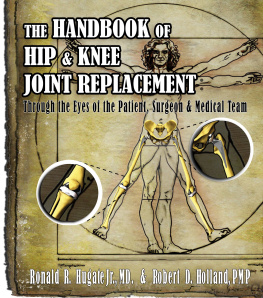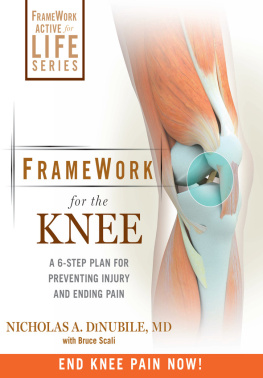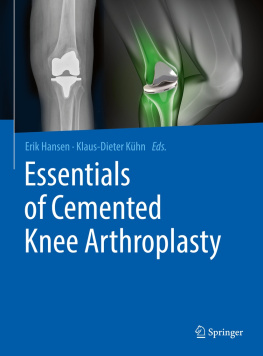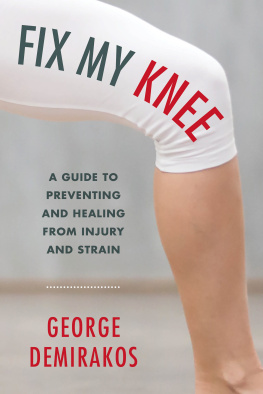Praise for
The Joint Kitchen
An extraordinarily helpful book about creative thinking, describing exactly what happens with me every day when I am writing.
ALAN TRUSTMAN, Author of Bullitt, The Thomas Crown Affair, Recipient of the Lifetime Achievement Award from the Cannes Film Festival
The Joint Kitchen by Michael Ries is a book like none other on the creative process that blends knowledge and unfocused thought leading to outside the box medical inventions. Dr. Ries goes beyond explaining his thought process of discovery to a description of the silent zone, that ushers in the alchemy of the Eureka moment. Invention after invention pour out of his ability to see shapes in common objects, their natural utility and his brains own sense of itself. His opening up to his silent zone is an exact description of our brains ability to drop into the recently discovered Default Mode Network, where many believe the deepest parts of our true sense of Self exists. This critical process is centrally involved in all creative endeavors.
MICHAEL H. MOSKOWITZ, MD, MPH, Pain Management Specialist and Author of Medical Cannabis: A Guide for Patients, Practitioners, and Caregivers
Dr. Ries is an exceptional surgeon and innovator. His lessons from the silent zones of the kitchen and the outdoors provide useful guidance for innovators and for patients regarding tapping inner creativity, and applying lessons from our everyday life experience to novel utilization. This book is a must read for anyone who may hope to improve creative thinking, and to innovate and problem solve using out of the box thinking.
SIGURD BERVEN, MD, Professor and Chief of Spine Service, Department of Orthopaedic Surgery, UC San Francisco
A necessary read for anyone who is considering knee or hip replacement, or anyone who wishes to become an inventor in the prosthetic field, in fact, anyone who hopes to become the next Leonardo da Vinci!
MICHAEL E. DAVIES, Renowned Emergency Room andTrauma Physician
The Joint Kitchen presents similes of everyday events which provide solutions for complex orthopaedic problems.
SETH GREENWALD, D.Phil.(Oxon), Director, Orthopaedic Research Laboratories, Cleveland, OH
The Joint Kitchen
A Handbook for Orthopaedic Inventors and
Fraidy Cats Facing a Knee or Hip Replacement
Michael David Ries, MD

VIRGINIA BEACH
CAPE CHARLES
The Joint Kitchen
by Michael David Ries, MD
Copyright 2017 Michael David Ries, MD
ISBN 978-1-63393-532-7
All rights reserved. No part of this publication may be reproduced, stored in a retrieval system, or transmitted in any form or by any meanselectronic, mechanical, photocopy, recording, or any otherexcept for brief quotations in printed reviews, without the prior written permission of the author.
Published by

210 60th Street
Virginia Beach, VA 23451
800-435-4811
www.koehlerbooks.com

PREFACE
THE LEFT SIDE of our brain is the logical side that figures things out. The right side of our brain is the artistic side. You probably know which one drives you. But sometimes the right and left sides of our brain talk to each otherand thats when special things happen.
Do you know the story about how Sir Isaac Newton watched an apple fall from a tree in an orchard and then he figured out gravity? He probably wasnt trying to understand why people dont fly, and he probably wasnt thinking about an apple. So it just happened.
How about Einstein? There is a story that while playing a violin he had a dream about horses racing across the sky and then thought of the theory of relativity. An entire book has been written about Einsteins dreams.
Friedrich August Kekule was a German chemist trying to figure out the structure of benzene. It seems that he discovered the ring shape of the benzene molecule after having a dream about a snake seizing its own tail.
These were very special people who did amazing things. But what makes these stories believable? They all have three elements that we are familiar with.
There was awareness of a problem with no solution.
An almost magical zone of silence occurred when the conscious mind was happily inactive and the unconscious side of the brain was free to think out loud.
A connection occurred between conscious and unconscious thoughts that resulted in a creative idea.
So what about regular people, like you and me, and the stranger next to us? Maybe we wont save the planet, but we could have a compelling idea.
The brain is amazing. It runs without an on-off switch. Even when we are sleeping its doing something, like making sure we breathe and our heart beats, and that we dream. If the Isaac Newton story is true, he was standing in an orchard not doing much. If the Einstein story is accurate, he was peacefully playing the violin. If the Kekule folklore is true, he had a dream, probably during sleep. So, maybe what they were doingand whenwere both important; their brain was in the right place at the right time to solve a problem.
You might wonder whether ideas come from familiar images or they just happen. When we get ideas, does it matter what we are doing? Do they come from dreams? Will an idea surface when your heads drifting or so bored that your mind goes blank? Or, will ideas percolate if you try hard enough?
One of the aboveor some combination of all threehappened to me. While doing ordinaryeven mundanerepetitive activities I noticed some things about joint function that resulted in hip-and-knee-replacement inventions. In all, I have been an inventor of forty-five patents intended to improve joint-replacement technologies. In each case, they resulted from a simple question: How can we do this better?
I cannot claim that working in the kitchen, opening a bottle of wine, or slicing an orange inspired or directly influenced my inventions. But what I do know is exactly where I was and what I was doing when the ideas for these joint-replacement improvements hit me. In almost every case, I was doing something catharticlike cooking. In each case, my mind was relaxed or I was enjoying myself. Those were my moments of inspiration. Throughout the book, I call these solution-based moments Into the Silent Zone. Its when solutions to orthopaedic problems bubbled up or how I chose to illustrate them.
As an orthopaedic specialist, I perform hundreds of surgeries a year. So, my work is always top of mind. As with most surgeons, I always strive to improve surgical methods or technologies.
In the following pages, I write about seven surgical or technological problems I encountered, and the solution. You will see that I use somewhat complex anatomical illustrations to show what Im writing about, and images of basic household items or foods that either influenced my invention or help to explain it.
My intention with this book is to inspire creative thinking through common tasks, and to show in more technical detail the fruits of those brainstorms. I hope that my method for finding solutions inspires others in various professional fields. My inventions show how ordinary thoughts coming at calm moments can lead to extraordinary ideas.
I hope you enjoy my story and benefit from what I have learned.




